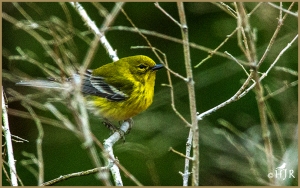Birds of the Week # 14
Pine Warbler
They forage slowly on tree trunks and branches by poking their bill into pine cones. These birds also find food by searching for it on the ground. These birds mainly eat insects, seeds and berries.
Their nests are deep, open cups, which are placed near the end of a tree branch. Pine Warblers prefer to nest in pine trees, hence their names. Three to five blotched white eggs are laid.
Tufted Titmouse
The Tufted Titmouse gathers food from the ground and from tree branches. It eats berries, nuts, insects, small fruit, snails, and seeds. Caterpillars constitute a major part of its diet during the summer. Titmice will stash food for later use. The titmouse can demonstrate curiosity regarding humans, and sometimes will perch on a window ledge and seem to be peering into the house. It may cling to the windows and walls of buildings seeking prey in wasp and hornet nests. It is a regular visitor around bird feeders. Its normal pattern is to scout a feeder from cover, fly in to take a seed, then fly back to cover to eat it
Boat-tailed Grackle (Male)
Boat-tailed Grackle (Female)
Young males are black but lack the adult’s iridescence. Immature females are duller versions of the adult female and have blotches or spots on the breast. The eye color of the Boat-tailed Grackle varies with range. Gulf Coast and inland birds have dark eyes, whereas Atlantic birds have pale eyes.
Red-winged Blackbird (Male)
Young birds resemble the female, but are paler below and have buff feather fringes. Both sexes have a sharply pointed bill. The tail is of medium length and is rounded. The eyes, bill, and feet are all black. Unlike most North American passerines which develop their adult plumage in their first year of life so that the one-year-old and the oldest individual are indistinguishable in the breeding season, the Red-winged Blackbird does not. It acquires its adult plumage only after the breeding season of the year following its birth when it is between thirteen and fifteen months of age. Young males go through a transition stage in which the wing spots have an orange coloration before acquiring the most intense tone typical of adults.
Brown-headed Cowbird
Brown-headed Cowbirds do not raise their own young; instead, they lay their eggs in the nests of other bird species. As a result, young cowbirds are not exposed to species-typical visual and auditory information like other birds. Despite this, they are able to develop species-typical singing, social, and breeding behaviors. Cowbird brains are wired to respond to the vocalizations of other cowbirds, allowing young to find and join flocks of their own species. These vocalizations are consistent across all cowbird populations, and serve as a sort of species-recognition password. If a young cowbird is not exposed to these “password” vocalizations by a certain age, it will mistakenly imprint on the host species.
© HJ Ruiz – Avian101











A great selection of bird portraits.
Thanks so much, Susan. 🙂
I do love the pine warbler’s colors Lee and the Tufted Titmouse. The latter name reminds me always of our champion swimmer yesterday winning Gold at Tokyo. 🙂
Titmus, Titmouse…Yeah! Congratulations for the Gold. Thanks, Ashley. 🙂
Very nice shots, HJ! 🙂
Thank you so much, Donna. 🙂